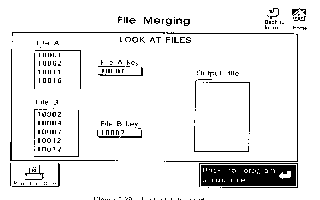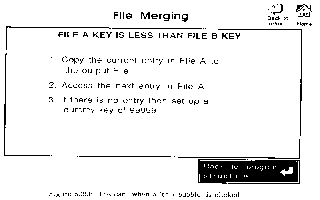


Ten students took part in an evaluation study and from
observation and questionnaire, Seth established that they were
impressed by his system and found the presented information easy
to understand and navigate. They also valued the presentation of
several options and the fact they could decide which to pursue.
Seth also reported on the simplicity of the authoring
environment: the hypermedia system was reasonably easy to set
up, enabling the designer to concentrate on the design of
materials themselves. Seth acknowledged the problem of becoming
'lost in hyperspace' and suggested that a future development
might be to incorporate an Artificial Intelligence component
which could maintain the learning goals by giving intelligent
advice about the best direction to take through the hypertext
material at any particular time.
In another hypertext study, Clark J (1993) and Abbott (1993)
collaborated on development of a prototype IV guide to the
facilities available to students within and around Leeds
Metropolitan Univerisity. Although not intended directly as a
learning system, it is of interest in that it could potentially
form the basis of a student-centred browsing system for
learning. In evaluating the system, Clark found better retention
of presented material by those who had viewed facilities in the
IV guide as compared to those students who had read about them
in the conventionally published student guide. This IV guide was
programmed by Clark in dBase. As an alternative design, Abbott
built the same IV guide on top of the framework of a hypertext
system. He also found a greater learnability with the IV system
than with the text-only hypertext equivalent.
Another open discovery guidance system was followed up by
Clark A (1993) who aimed to develop a design for an art gallary
guide based upon the concept of an electronic book offering
text, graphics (digitised paintings), audio (expert opinions),
and video (for appropriate films of background and related
material). In his design prototype, pages and sections of the
book are linked together using hypertext principles to enable
the visitor to explore related topics.
The prototype system was created using the 'notepad' facility
of the Lotus Organiser package through which pages could be
customised to include text and graphics which could then be
linked to any other pages. The metaphor used by Organiser is
that of a personal organiser, a multi-sectioned book with
coloured tabs indicating the location of each section.
A series of skeleton books was developed, each one
representing a different type of classification (by artist,
theme, picture type, artist gender, art gallery room,
chronological age, medium, country of origin, style). One book
was developed in full (an arrangement of works by artist) and
divided into a number of sections (help, artist, work,
criticism, style, medium, glossary and gallery plan). A tutorial
was created using Micrografx Charisma Slide Show to be used as
an introduction to the prototype system.
Two types of potential users were identified. Firstly, casual
visitors who may visit the gallery possibly only once might wish
to find out more about a work they have seen which appeals to
them, or alternatively browse the system in a more random or
linked way to discover information which will then lead them to
view a work in the gallery. Secondly, those with an active
interest in art may use the guide in order to extract more
detailed and specific information; from their wider perspective
and familiarity with art terminology they will gain a greater
appreciation of the more complex topics.
The information was structured in terms of a 'web' which it
was felt was more appropriate in conforming to the traditional
relationship of one page to the next in a book metaphor. In this
respect the structure was analogous to the stacks used by the
Apple MacIntosh HyperCard system. Access to topics and material
within the guide could take place using section tabs, contents
pages, pull-down links, dedicated link pages, sequential page
turning, free text search, and pull-down menus. The defining and
use of hot areas was unfortunately not a feature available
within that version of Organiser. Figure 2 (4.3a-d) shows some
example pages from the prototype guide book. A comprehensive
evaluation through questionnaire of the system using 40
questions with 22 subjects chosen from both types of user
resulted in an overall positive response. The book metaphor was
considered by users to be successful and to compare favourably
with paper guide books.
Both Clark's and Nichols' systems present intriguing possibilities within an educational setting. Nichols' system could greatly facilitate retrieval of educational materials, especially for distance learning students. Clark's could form the basis for the front end to a teaching system, the metaphor being that students could move around a teaching room with the appropriate subject visibly materials laid out for their selection and educational study.
A relatively simple enhancement would be to allow the student
to take snapshots of such screens as they deem appropriate, and
thus build their own individualised learning resource, after the
manner of Tait (1987). A more complex, but potentially very
valuable, enhancement of allowing for a mixed initiative
dialogue as part of the teaching interaction, is currently being
investigated (Moore and Hobbs 1992, see also another paper in
this WWW collection).
Longer term developments will include the utilisation of a
wider range of media, such as Compact Disc Interactive (CD-I),
and Digital Video Interactive (DVI). More tentatively, the work
of Nichols (1993) and Clark A (1993) described earlier in this
paper raises the possibility of incorporating Virtual Reality in
learning systems after the manner of Blackwell (1992) and is
worthy of further investigation when such systems become
sufficiently developed and affordable. Much of the work may
parallel studies elsewhere involving 'electronic books' (eg
Barker and Giller 1992) which may well become more commonplace
with the recent arrival on the market of hand-held CD-ROM/CD-I
players with miniature screen and keyboard and powerful
keyboardless personal organisers with handwriting recognition.
Atkins M J and Blisset G (1988),
Barker J and Tucker R N (1990),
Barker P and Giller G (1992)
BBC Enterprises Ltd (1986),
Bielawski L and Lewand R (1991),
Blackwell L (1992),
Chadwick S,
Chow J (1990),
Clark J (1993),
Clark A (1993),
Conklin J (1987),
Davies R K (1993),
Dobby D (1989),
Doulton, A (1986),
Fendley C (1988),
Ford L (1986),
Goldstein I P (1982),
Goodship G (1992),
Haynes T R and Parslow G R (1986),
Hobbs D J (1988),
Hobbs D J (1990),
Hussein A (1990),
Ibrahim AARA (1993),
Jagger V (1993),
Kay P (1991),
Mashiter J (1988),
Moore D and Hobbs D J (1992),
Morris K (1990),
Nichols S (1993),
NIVC (1986),
NIVC (1990),
Peachy D R and McCalla G I (1986)
Perkin R (1990),
Platts I (1989),
Pountain D (1992),
Prewitt G, Tucker S A and Kilgore B (1992),
Seth A F A (1992),
Shelley D J (1992),
Smith R (1986),
Stephenson P (1993),
Tait K (1987),
Thomason I (1989),
Tucker S, Dempsey J, McMahan H, Gray B, Bowen D and Bowen P
(1992)
Wong A (1990),
The Interactive Learning
Revolution, Kogan-Page
Electronic Books for Distance
Learning, in Proceedings of the Ninth International Conference
on Technology and Education, Paris Vol 2
National Disk: The Domesday Gallery
Intelligent Systems Design:
Integrating Expert Systems, Hypermedia, and Database
Technologies, John Wiley and Sons
The Virtual Reality Learning Paradigm in
Real Time Curriculum, in Proceedings of the Ninth International
Conference on Technology and Education, Vol 2
A Comparison of Linear and Interactive Means of
Presenting Video, Unpublished undergraduate dissertation, Leeds
Metropolitan University, UK
An investigation of methods to improve access
time for an Interactive Video tape data retrieval system,
Unpublished undergraduate dissertation, Leeds Metropolitan
University, UK
A Study of the Development of an interactive
Video Guide and Surrogate Walk, Unpublished undergraduate
dissertation, Leeds Metropolitan University, UK
A Hypermedia Guide to an Art Gallery,
Unpublished undergraduate dissertation, Leeds Metropolitan
University, UK
Hypertext: An Introduction and Survey, in
Computer September 1987, pp17-43
A study into the uses, objectives and
implications of interactive media and public access systems in
advertising and retail, Unpublished undergraduate dissertation,
Leeds Metropolitan University, UK
A comparison of methods for controlling an
Interactive Video, Unpublished undergraduate dissertation, Leeds
Metropolitan University, UK
Interactivity; Does it mean anything?, in
Computer Controlled Interactive Video (ed Droar T), Gower
Technical Press
An Intelligent knowledge-based educational
Advisor, Unpublished undergraduate dissertation, Leeds
Metropolitan University, UK
A new intelligent tutoring system, in Interactive
Learning International, Vol 3 No 4
The genetic graph: a representation for
the evolution of procedural knowledge, in Intelligent Tutoring
Systems, (eds Sleeman D and Brown J S), Harcourt Brace
Jovanovich
Computer based training for managers,
Unpublished undergraduate dissertation, Leeds Metropolitan
University, UK
Videodisk: a challenge to
educators, In Proceedings of the 4th Computer Aided Learning in
Tertiary Education conference, Adelaide, (eds Bishop G and Van
Lint W) pp143-6
Design of a knowledge-based educational
Advisor, in Programmed Learning and Educational Technology, Vol
25, No 4
Second level design of a knowledge-based
educational Advisor, in Educational and Training Technology
International, Vol 27 No 2
A study into the use of Interactive Video as a
learning aid and comparison with traditional methods,
Unpublished undergraduate dissertation, Leeds Metropolitan
University, UK
A Multimedia Guide to Leeds Metropolitan
University's Prospectus, Unpublished undergraduate dissertation,
Leeds Metropolitan University, UK
Helping Your Child to Read: An Interactive
Video Information Program for Parents, Unpublished undergraduate
dissertation, Leeds Metropolitan University, UK
A reference model for the design of interactive
video tutoring systems in a hypertext environment, Unpublished
undergraduate dissertation, Leeds Metropolitan University, UK
Planning, piloting and producing an
Interactive Videodisk, in Proceedings of the Fifth International
Conference on Technology and Education, Vol 2
Discussion-based intelligent
tutoring, in Proceedings of the Ninth International Conference
on Technology and Education, Paris Vol 3
Design and evaluation of methods for
interacting graphically with the knowledge domain in a
knowledge-based educational Advisor, Unpublished undergraduate
dissertation, Leeds Metropolitan University, UK
A Virtual Reality Library System, Unpublished
undergraduate dissertation, Leeds Metropolitan University, UK
An introduction to Interactive Video, National
Interactive Video Centre, UK
Interactive Yearbook 1990, National Interactive
Video Centre, UK
Using planning techniques in
intelligent tutoring systems, in International Journal of
Man-Machine Studies, Vol 24
The role of student modelling in an intelligent
interactive videodisk tutoring system, Unpublished undergraduate
dissertation, Leeds Metropolitan University, UK
A comprehensive study of interactive video
technology with particular reference to the design of an
efficient IV tape tutorial system, Unpublished undergraduate
dissertation, Leeds Metropolitan University, UK
Browsing Art the Windows Way, Byte April
pp13-24
Using 'On Screen'
Video, Multimedia Applications, and Instructional Design to
Enhance the Development of Interactive Instruction, in
Proceedings of the Ninth International Conference on Technology
and Education, Paris Vol 1.
Use of hypertext for teaching packages,
Unpublished undergraduate dissertation, Leeds Metropolitan
University, UK
The VCR and the Microcomputer: A Creative
Combination, in Proceedings of the Ninth International
Conference on Technology and Education, Paris Vol 2
Interactive video - why and a case study of how,
in Media in Education and Development, June 1986
Interactive Video in the National Health
Service, Unpublished undergraduate dissertation, Leeds
Metropolitan University, UK
The study station concept in computer-based
learning, in University Computing, Vol 9 pp25-28
Student modelling in a computer assisted
interactive video environment, Unpublished undergraduate
dissertation, Leeds Metropolitan University, UK
Evaluating Instructional Hypermedia with Semiotics, in
Proceedings of the Ninth International Conference on Technology
and Education, Paris Vol 1
An investigation of possible search strategies
and mechanisms for use in a knowledge-based educational Advisor,
Unpublished undergraduate dissertation, Leeds Metropolitan
University, UK
